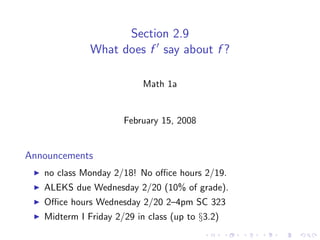
Lesson 7: What does f' say about f?
- 1. Section 2.9 What does f say about f ? Math 1a February 15, 2008 Announcements no class Monday 2/18! No office hours 2/19. ALEKS due Wednesday 2/20 (10% of grade). Office hours Wednesday 2/20 2–4pm SC 323 Midterm I Friday 2/29 in class (up to §3.2)
- 2. Outline Cleanup Increasing and Decreasing functions Concavity and the second derivative
- 3. Last worksheet, problem 2 Graphs of f , f , and f are shown below. Which is which? How can you tell? y x
- 4. Solution Again, look at the horizontal tangents. The short-dashed curve has horizontal tangents where no other curve is zero. So its derivative is not represented, making it f . Now we see that where the bold curve has its horizontal tangents, the short-dashed curve is zero, so that’s f . The remaining function is f .
- 5. Outline Cleanup Increasing and Decreasing functions Concavity and the second derivative
- 6. Definition Let f be a function defined on and interval I . f is called increasing if f (x1 ) < f (x2 ) whenever x1 < x2 for all x1 and x2 in I .
- 7. Definition Let f be a function defined on and interval I . f is called increasing if f (x1 ) < f (x2 ) whenever x1 < x2 for all x1 and x2 in I . f is called decreasing if f (x1 ) > f (x2 ) whenever x1 < x2 for all x1 and x2 in I .
- 11. Fact If f is increasing and differentiable on (a, b), then f (x) ≥ 0 for all x in (a, b)
- 12. Fact If f is increasing and differentiable on (a, b), then f (x) ≥ 0 for all x in (a, b) If f is decreasing and differentiable on (a, b), then f (x) ≤ 0 for all x in (a, b).
- 13. Fact If f is increasing and differentiable on (a, b), then f (x) ≥ 0 for all x in (a, b) If f is decreasing and differentiable on (a, b), then f (x) ≤ 0 for all x in (a, b). Proof. Suppose f is increasing on (a, b) and x is a point in (a, b). For h > 0 small enough so that x + h < b, we have f (x + h) − f (x) f (x + h) > f (x) =⇒ >0 h So f (x + h) − f (x) lim+ ≥0 h→0 h A similar argument works in the other direction (h < 0). So f (x) ≥ 0.
- 14. Example Here is a graph of f . Sketch a graph of f .
- 15. Example Here is a graph of f . Sketch a graph of f .
- 16. Fact If f (x) > 0 for all x in (a, b), then f is increasing on (a, b). If f (x) < 0 for all x in (a, b), then f is decreasing on (a, b).
- 17. Fact If f (x) > 0 for all x in (a, b), then f is increasing on (a, b). If f (x) < 0 for all x in (a, b), then f is decreasing on (a, b). The proof of this fact requires The Most Important Theorem in Calculus.
- 18. Outline Cleanup Increasing and Decreasing functions Concavity and the second derivative
- 19. Definition A function is called concave up on an interval if f is increasing on that interval.
- 20. Definition A function is called concave up on an interval if f is increasing on that interval. A function is called concave down on an interval if f is decreasing on that interval.
- 21. Fact If f is concave up on (a, b), then f (x) ≥ 0 for all x in (a, b)
- 22. Fact If f is concave up on (a, b), then f (x) ≥ 0 for all x in (a, b) If f is concave down on (a, b), then f (x) ≤ 0 for all x in (a, b).
- 23. Fact If f (x) > 0 for all x in (a, b), then f is concave up on (a, b). If f (x) < 0 for all x in (a, b), then f is concave down on (a, b).
